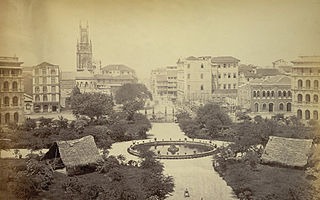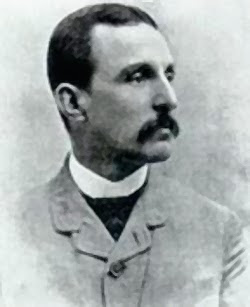
Chhatrapati Shivaji Terminus (officially Chhatrapati Shivaji Maharaj Terminus since 2017, formerly Victoria Terminus (VT), Bombay station code: CSMT (mainline)/ST (suburban)), is a historic railway terminus and UNESCO World Heritage Site in Mumbai, Maharashtra, India.

Kala Ghoda is a crescent-shaped art district/neighborhood in Mumbai, India. It hosts several of the city's heritage buildings including museums, art galleries and educational institutions like the Chhatrapati Shivaji Maharaj Vastu Sangrahalaya, the Jehangir Art Gallery, the National Gallery of Modern Art, and The Arts Trust - Institute of Contemporary Indian Art.

Crawford Market is one of South Mumbai's most famous markets. The building was completed in 1869, and donated to the city by Cowasji Jehangir. Originally named after Arthur Crawford, the first Municipal Commissioner of the city, the market was later renamed to honour Indian social reformer Mahatma Jotirao Phule. The market is situated opposite the Mumbai Police headquarters, just north of Chhatrapati Shivaji Terminus railway station and west of the J.J. flyover at a busy intersection. It was the main wholesale market for fruits in Mumbai until March 1996, when the wholesale traders were relocated to Navi Mumbai.

Jehangir Art Gallery is an art gallery in Mumbai (India). It was founded by Sir Cowasji Jehangir at the urging of K. K. Hebbar and Homi Bhabha. It was built in 1952. Managed by the Committee of Management, the entire cost of this mansion was donated by Cowasji Jehangir. This gallery is situated at Kala Ghoda, behind the Prince of Wales Museum, in South Mumbai near the Gateway of India, and has four exhibition halls. The gallery was designed by G.M.Bhuta for G.M. Bhuta & Associates. The gallery closed for 11 months as a part of the COVID-19 lockdown in India and was partially re-opened on 16 February 2021.

The Horniman Circle Gardens is a large park in South Mumbai, Maharashtra, India, which encompasses an area of 1.01 hectares. It is situated in the Fort district of Mumbai, and is surrounded by office complexes housing the country's premier banks. Designed to be a large open space with grand buildings in the middle of the walled city, the area had been known as Bombay Green in the 18th century, later Elphinstone Circle. Following India's independence in 1947, the area was renamed in honour of Benjamin Horniman, editor of The Bombay Chronicle newspaper, who supported Indian independence.

Watson's Hotel, now known as the Esplanade Mansion, located in the Kala Ghoda area of Mumbai (Bombay), is India's oldest surviving cast iron building. It is probably the oldest surviving multi-level fully cast-iron framed building in the world, being three years earlier than the Menier Chocolate Factory in Noisiel, France, which are both amongst the few ever built. Named after its original owner, John Watson, the cast and wrought iron structure of the building was prefabricated in England, and it was constructed between 1867 and 1869.

Elphinstone College is one of the constituent colleges of Dr. Homi Bhabha State University, a state cluster university. Established in 1856, it is one of the oldest colleges in Mumbai. It played a major role in shaping and developing the educational landscape of the city. It also played a pivotal role in the inception of the University of Mumbai.

Fort is a business and art district in the city of Mumbai, Maharashtra, India. The area gets its name from the defensive fort, Fort George, built by the British East India Company around Bombay Castle.

The David Sassoon Library and Reading Room is a famous library and heritage structure in Mumbai, India. The idea for a library to be situated in the center of the city came from Albert Sassoon, son of the famous Baghdadi Jewish philanthropist, David Sassoon.

Frederick William Stevens was an English architectural engineer who worked for the British colonial government in India. Stevens' most notable design was the railway station Victoria Terminus in Bombay.

The Kala Ghoda Arts Festival is annual festival, nine days long, commencing always on the first Saturday of February and closing is always on the second Sunday in February, in the Kala Ghoda area of South Mumbai, India.

Dadabhai Naoroji Road (D.N.Road), a North–South commercial artery road, in the Fort business district in South Mumbai of Maharashtra, India, is the nerve centre of the city, starting from the Mahatma Phule Market ,linking Chhatrapati Shivaji Maharaj Terminus, leads to the Hutatma Chowk at the southern end of the road. This entire stretch of the road is studded with Neo–Classical and Gothic Revival buildings and parks built in the 19th century, intermingled with modern office buildings and commercial establishments.
The architecture of Mumbai blends Gothic, Victorian, Art Deco, Indo-Saracenic & Contemporary architectural styles. Many buildings, structures and historical monuments remain from the colonial era. Mumbai, after Miami, has the second largest number of Art Deco buildings in the world.

Many heritage structures are found in Mumbai, India.

Church of St Andrew and St Columba is a church with two separate buildings located in Kala Ghoda and Fort in Mumbai, India. It was Bombay's first Scottish church and was built in 1819 after the arrival of the city's first Presbyterian minister, James Clow, who was appointed chaplain for the East India Company in 1815. The two Scottish churches were merged in 1938.

Bomanjee Hormarjee Wadia Clock Tower is a heritage structure in Fort, Mumbai, India, that was erected in 1882 using public funds as a token of appreciation for Bomanjee Hormarjee Wadi, a Parsi philanthropist who had contributed to the cause of education in the city. He was a member of the Bombay Native Education Society and on the board of Elphinstone Institution. He died on 3 July 1862.
Vikas Dilawari is an Indian conservation architect who has restored at-risk monuments and heritage buildings in Mumbai, including the Victoria Terminus, Rajabai Clock Tower, Dr. Bhau Daji Lad Museum, Wellington Fountain and Christ Church, Byculla. 16 restoration projects carried out by his team have been recognised by the UNESCO Asia-Pacific Awards for Cultural Heritage Conservation, including the 2019 work on the Flora Fountain, which was designed by architect Richard Norman Shaw and completed in 1864.

Wellington Fountain is a listed heritage structure in front of Maharashtra Police Headquarters at Shyamaprasad Mukherjee Chowk in Fort, Mumbai, which is part of Mumbai's Victorian ensemble that is a UNESCO World Heritage Site. It was erected in 1865 to commemorate the visits of Arthur Wellesley, 1st Duke of Wellington, who came to India in 1801 and 1804.

Maharashtra Police Headquarters building is a Grade I listed UNESCO World Heritage Site in South Mumbai that was built between 1872 and 1876, and designed by the British architect Frederick William Stevens, who also designed the Chhatrapati Shivaji Maharaj Terminus. The building is often confused with Mumbai Police Headquarters, also built in Gothic Revival style, and several newspapers often carry the image of Maharashtra headquarters while reporting on the latter. The headquarters are located at Wellington Circle in Fort, and face the Wellington Fountain.

Sameer Kulavoor is an Indian contemporary artist and founder of one of the earliest specialised design studios in India, Bombay Duck Designs.


















